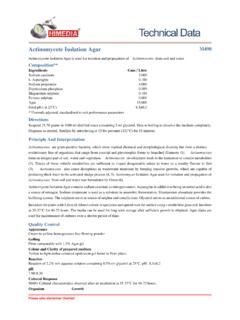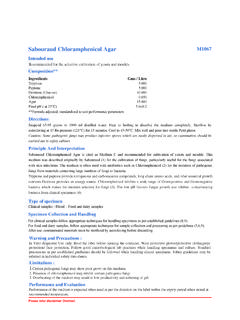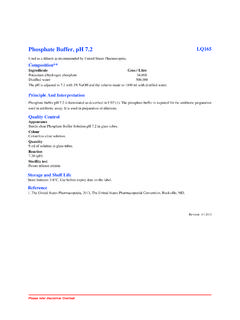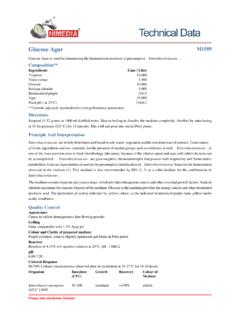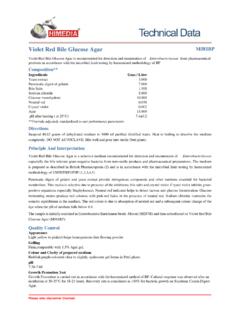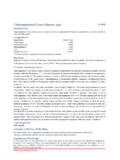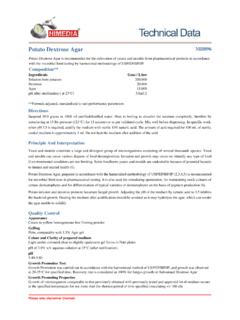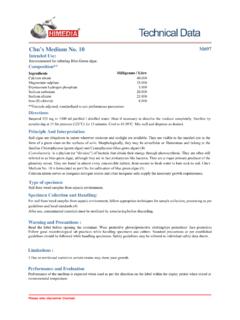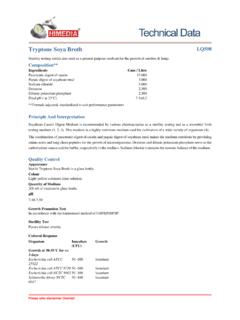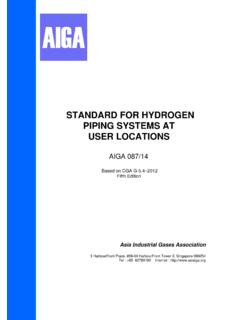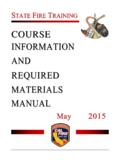Transcription of EC Broth - himedialabs.com
1 Please refer disclaimer BrothM127 Intended Use:EC Broth is recommended for the selective enumeration of presumptive Escherichia coli by MPN technique from water samples and from clinical samples. Composition**IngredientsGms / salts pH ( at 25 C) **Formula adjusted, standardized to suit performance parametersDirectionsSuspend 37 grams in 1000 ml distilled water. Heat if necessary to dissolve the medium completely. Dispense in test tubescontaining inverted Durhams tube. Sterilize by autoclaving at 15 lbs pressure (121 C) for 15 minutes. Adjust the concentrationof medium in accordance with sample And InterpretationEC Medium is used for detection of coliforms during bacteriological examination of water, milk and foods. It was originally described by Hajna and Perry (1). This medium was later used by Fishbein and Surkiewicz to carry out Escherichia coli confirmatory tests (2).
2 It is also used in MPN methods (3) and is often used for confirmation of coliforms. The procedure employing EC Medium provides information regarding the source of the coliform group (fecal or non-fecal) when used as a confirmatory test (4). EC Broth should not be used for the direct isolation of coliforms since prior enrichment in a presumptive medium for optimal recovery of fecal coliforms is provides nitrogeneous and carbonaceous compounds, long chain amino acids and other essential growth nutrients. Lactose is the fermentable sugar. Bile salts mixture inhibit gram-positive bacteria especially bacilli and faecal Streptococci. Phosphates control the pH during fermentation of lactose. Gas production in a fermentation tube within 24 hour or less is a presumptive evidence of the presence of coliform bacteria. This medium can be used at 37 C for the detection of coliform organisms or at C for the isolation of Escherichia coli from water and shellfish) or C for using sample more than 10 ml, the medium must be reconstituted at a concentration equivalent to that specified on the directions, once the sample is added, the working procedure is as follows:Transfer a loopful of culture from all the tubes of Lauryl Sulphate Broth (M080) showing gas formation within 24 hours and from all the tubes showing xbacterial growth within 48 hours to EC Broth tubes.
3 Within 30 minutes from the inoculum, place the tubes in a water bath and incubate at 44 C for 24 hours. Consider the growth showing gas production as the density of the faecal coliform organisms by using MPN tables. False-negative reactions in recovering coliformsfrom water supplies can occur due to low pH, refrigeration and use of bactericidal or bacteriostatic agents (5).Gas formation at C or C (and 37 C) Escherichia coli , possibly also other formation at 37 C Coliform bacteria without Escherichia coliHiMedia LaboratoriesTechnical DataPlease refer disclaimer of specimen Clinical - faeces ; Food samples; Water sampleSpecimen Collection and HandlingFor clinical samples follow appropriate techniques for handling specimens as per established guidelines (7,8). For food and dairy samples, follow appropriate techniques for sample collection and processing as per guidelines (4,6,10). For water samples, follow appropriate techniques for sample collection, processing as per guidelines and local standards.
4 (3,5) After use, contaminated materials must be sterilized by autoclaving before discarding. Warning and PrecautionsIn Vitro diagnostic use only. Read the label before opening the container. Wear protective gloves/protective clothing/eye protection/face protection. Follow good microbiological lab practices while handling specimens and culture. Standard precautions as per established guidelines should be followed while handling clinical specimens. Safety guidelines may be referred in individual safety data identification, organisms must be in pure culture. , biochemical and/or serological tests should be performed for final and EvaluationPerformance of the medium is expected when used as per the direction on the label within the expiry period when stored at recommended ControlAppearanceCream to yellow homogeneous free flowing powderColour and Clarity of prepared mediumYellow coloured, clear solution without any precipitateReactionReaction of w/v aqueous solution at 25 C.
5 PH : ResponseCultural characteristics observed after an incubation at C for 24 ResponseOrganismInoculum(CFU)GasCultural ResponseKlebsiella pneumoniae ATCC 13883 (00097*)50-100 good-luxuriantpositivereactionPseudomona s aeruginosa ATCC 27853 (00025*)50-100negativereactionEnterococc us faecalis ATCC29212 (00087*)>=10 Bacillus subtilis subsp.>=10 spizizenii ATCC 6633 (00003*) 50-100 good-luxuriantpositivereaction>=10 Growthfair to goodinhibitedinhibitedinhibitedEscherich ia coli ATCC25922 (00013*)# Klebsiella aerogenes ATCC 13048 (00175*)Key *- Corresponding WDCM Numbers ; # - Formerly known as Enterobacter aerogenesHiMedia LaboratoriesTechnical DataPlease refer disclaimer must ensure safe disposal by autoclaving and/or incineration of used or unusable preparations of this product. Follow established laboratory procedures in disposing of infectious materials and material that comes into contact with clinical sample must be decontaminated and disposed of in accordance with current laboratory techniques (7,8).
6 Reference1. Hajna A. A. and Perry C. A., 1943, Am. J. Public Health, 33 Fishbein M. and Surkiewicz B. F., 1964, Appl. Microbiol., 12 A. E., Clesceri L. S. and Eaton A. D., (Eds.), 2005, Standard Methods for the Examination of Water andWastewater, 21st ed., APHA, Washington, Marshall, (Ed.), 1993, Standard Methods for the Examination of Dairy Products, 16th Ed., American Public HealthAssociation, Washington, B., 1986, J. Food Prot., 49:651. 6. Rice , Baird, , Eaton A. D., Clesceri L. S. (Eds.), 2012, StandardMethods for the Examination of Water and Wastewater, 22nd ed., APHA, Washington, and Shelf LifeStore below 30 C in a tightly closed container and the prepared medium at 15-25 C. Use before expiry date on the label. On opening, product should be properly stored dry, after tightly capping the bottle inorder to prevent lump formation due to the hygroscopic nature of the product. Improper storage of the product may lead to lump formation.
7 Store in dry ventilated area protected from extremes of temperature and sources of ignition Seal the container tightly after use. Use before expiry date on the label. Product performance is best if used within stated expiry S., Shelton J. and Mitchell T., 1970, Methods in Microbiology', Norris J. and Ribbons D., (Eds.), Vol. 3A, AcademicPress, F. P. and Ito K., (Ed.), 2001, Compendium of Methods for the Microbiological Examination of Foods, 4th Ed.,American Public Health Association, Washington, , Clinical Microbiology Procedures Handb0ook. 2nd , , Pfaller , , Carroll, , Funke, G., Landry, , Richter, and Warnock., (2015)Manual of Clinical Microbiology, 11th Edition. Vol. H. M. and Frank J. H., 2004, Standard Methods for the Microbiological Examination of Dairy Products, 17th Ed.,APHA Inc., Washington, : 03 / 2018In vitro diagnostic medical device CE MarkingDo not use if package is damagedCE Partner 4U ,Esdoornlaan 13, 3951 DB Maarn The Netherlands, IVDS torage temperature10 C30 CEC REPHiMedia Laboratories Pvt.
8 Limited, 23 Vadhani Industrial Estate, LBS Marg,Mumbai-86,MS,India HiMedia LaboratoriesTechnical DataDisclaimer :User must ensure suitability of the product(s) in their application prior to use. Products conform solely to the information contained inthis and other related HiMedia publications. The information contained in this publication is based on our research and developmentwork and is to the best of our knowledge true and accurate. HiMedia Laboratories Pvt Ltd reserves the right to make changes tospecifications and information related to the products at any time. Products are not intended for human or animal or therapeutic use butfor laboratory,diagnostic, research or further manufacturing use only, unless otherwise specified. Statements contained herein should notbe considered as a warranty of any kind, expressed or implied, and no liability is accepted for infringement of any Laboratories Pvt.
9 Ltd. : 23, Vadhani , LBS Marg, Mumbai-400086, India. Customer care No.: 022-6116 9797 Corporate office : A-516,Swastik Disha Business Park,Via Vadhani Ind. Est., LBS Marg, Mumbai-400086, India. Customer care No.: 022-6147 1919 Email: Website.
